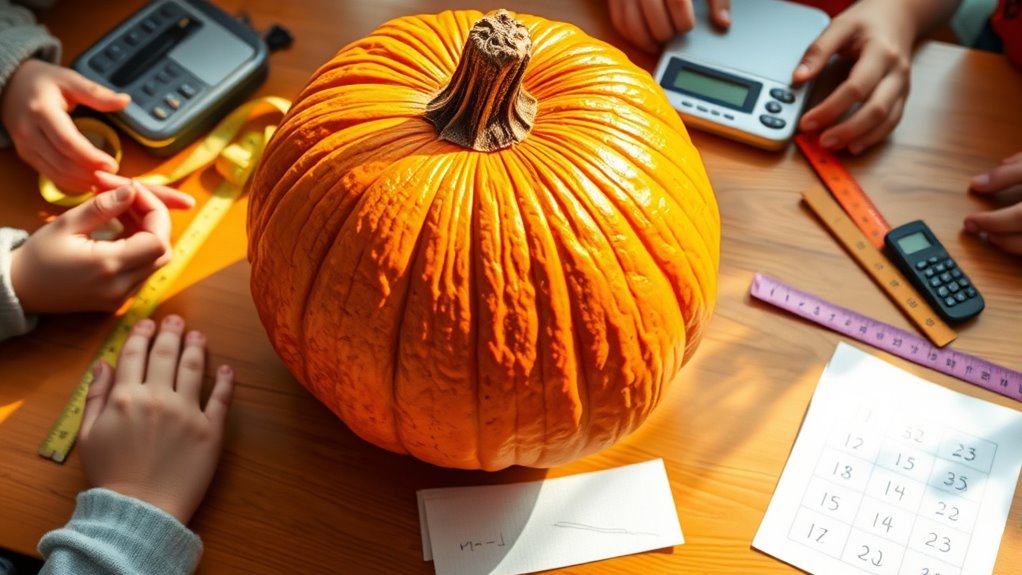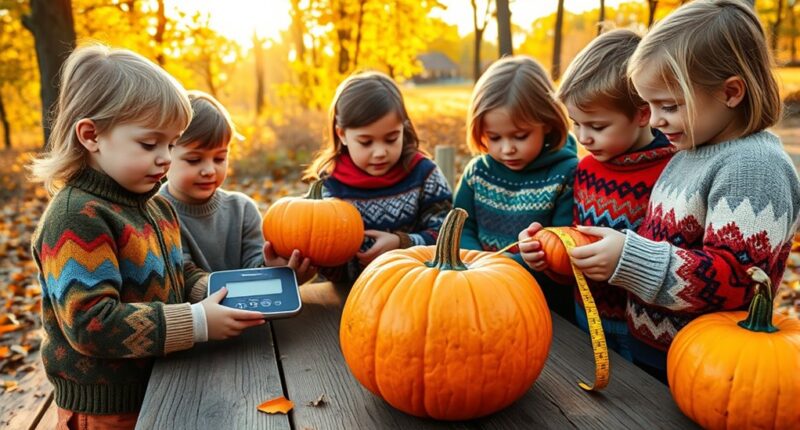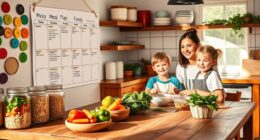Engaging in pumpkin activities is a fun way to practice weighing, measuring, and estimating together. As you pick pumpkins, try guessing their weight and compare sizes, then confirm with a scale. When carving or cooking, measure ingredients precisely and estimate amounts to boost your math skills. These hands-on tasks help you see how measurement works in real life while celebrating the season. Keep exploring, and you’ll find more ways to make math enjoyable and practical.
Key Takeaways
- Pumpkin activities develop estimation, measurement, and comparison skills through weighing, carving, and recipe adjustments.
- Hands-on pumpkin projects enhance spatial reasoning and problem-solving by dividing and shaping pumpkins.
- Cooking with pumpkin introduces measurement concepts, conversions, and proportional reasoning in a fun, practical context.
- Carving and weighing pumpkins foster real-world math understanding through estimation, measurement, and critical thinking.
- Seasonal pumpkin activities make math engaging and social, connecting numbers to enjoyable, hands-on experiences.

Have you ever wondered how pumpkins can help you learn math? It’s a fun and tasty way to connect numbers to real-world activities. When you carve pumpkins, you’re not just creating spooky faces; you’re also practicing measurement and spatial reasoning. Picking the right pumpkin size for your carving project involves estimating weight and volume, helping you develop skills in measurement and comparison. You might notice that larger pumpkins weigh more, but guessing just how much they weigh before weighing them on a scale challenges your estimation skills. As you carefully cut and scoop out the pumpkin’s insides, you’re engaging in precise measurement, learning about the differences between volume and weight, and understanding how to work with units. These activities turn pumpkin carving into a hands-on math lesson that’s both engaging and delicious. Creativity can be cultivated by anyone, making these activities accessible and fun for everyone.
Seasonal recipes involving pumpkin also give you countless opportunities to practice math. When you’re preparing pumpkin pies, soups, or muffins, you measure ingredients like flour, sugar, and spices. Converting measurements from cups to tablespoons or grams sharpens your understanding of units and ratios. For example, if a recipe calls for 2 cups of pumpkin puree, and you only have a ½-cup measuring cup, you need to do some quick multiplication to ensure you add the right amount. This process enhances your ability to estimate and convert measurements on the fly, which is a valuable skill in everyday cooking. Additionally, adjusting recipes for more or fewer servings requires you to double or halve ingredient amounts, reinforcing proportional reasoning.
Both pumpkin carving and seasonal recipes provide visual and tactile ways to grasp math concepts. When you carve a pumpkin into sections or estimate how much pumpkin you need for a recipe, you’re actively applying math in a context that’s easy to understand and enjoyable. These activities also promote critical thinking—deciding how to cut the pumpkin or how to measure ingredients accurately involves reasoning and problem-solving. You learn that math isn’t just about numbers on a page but a practical tool that helps you make decisions, plan, and create. Plus, sharing your carved pumpkins or seasonal dishes with family and friends turns learning into a social experience, making math both fun and meaningful. So next time you pick out a pumpkin or prepare a seasonal treat, remember—you’re practicing essential math skills in a way that’s delicious and rewarding.
Frequently Asked Questions
How Can Children Develop Better Measurement Skills Through Pumpkin Activities?
You can help children develop better measurement skills by encouraging them to estimate volume and compare weights of pumpkins. Have them guess how much a pumpkin weighs and then weigh it to see if they’re close. Ask them to compare the sizes and weights of different pumpkins, fostering their understanding of measurement concepts. These hands-on activities make learning fun and reinforce their skills in estimating, weighing, and measuring effectively.
What Safety Tips Are Recommended for Handling Large Pumpkins During Math Lessons?
Handling large pumpkins can feel like wrestling a giant, so always prioritize safety. Use handling precautions like gloves and sturdy tools to prevent slips or injuries. Confirm equipment safety by inspecting tools before use and keeping the workspace clear of obstacles. Never lift a pumpkin alone—teamwork makes the task manageable and safe. By following these tips, you protect yourself and create a secure, fun learning environment for your children.
Are There Educational Games Related to Pumpkin Math Suitable for Different Age Groups?
Yes, you can find educational pumpkin math games suitable for various age groups, featuring interactive puzzles and digital challenges. Younger kids enjoy simple online games that help them estimate pumpkin sizes or solve puzzles, while older students can tackle more complex digital challenges involving measurements and calculations. These engaging activities make learning fun, encourage critical thinking, and reinforce math concepts effectively during pumpkin-themed lessons.
How Can Teachers Assess Students’ Understanding of Measurement Concepts With Pumpkins?
Think of evaluating students’ understanding as planting seeds of curiosity. You can ask them to estimate the pumpkin’s weight and then measure its circumference, comparing guesses to actual results. Observe how confidently they estimate and measure, noting their precision and reasoning. Use their explanations to gauge comprehension, encouraging them to justify their estimates. This hands-on approach turns pumpkin measuring into a lively, insightful way to evaluate their grasp of measurement concepts.
What Are Creative Ways to Incorporate Pumpkin Math Into Holiday or Seasonal Curricula?
You can incorporate pumpkin math into your seasonal curriculum by blending pumpkin art projects with measurement activities, like creating pumpkin sculptures and estimating their weight or size beforehand. Integrate seasonal storytelling by having students craft stories about pumpkins, incorporating measurement concepts into the narratives. These creative activities make learning engaging, help students visualize math in real-world contexts, and celebrate the holiday spirit through hands-on, artistic, and literary exploration.
Conclusion
Now that you’ve explored pumpkin math, you see how weighing, measuring, and estimating can be fun and practical. Remember, a little practice goes a long way, and two heads are better than one. Keep experimenting with pumpkins, and you’ll become a math whiz in no time. As the saying goes, “Practice makes perfect.” So, grab your pumpkin and start measuring—your next great math adventure awaits!









